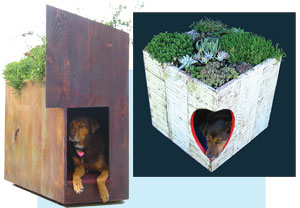BY ABIGIAIL GILMORE

Maybe you are spending time and money to make your home greener and better for the environment – but what about your pets’ homes? One company focuses on just that – creating sustainable houses for pets.
Stephanie Rubin, owner of Sustainable Pet Design, said the idea just came to her. “I recently earned a master’s degree in landscape design from a school that is very focused on environmental responsibility,” she said. “I learned about sustainable materials and practices, including greenroofs, low-VOC materials, and chemical-free building materials.”
After working as a landscape designer for a firm with no interest in sustainable design, Rubin became frustrated. She decided to make her own model of a greenroof (a roof partially or completely covered with vegetation) – on top of a doghouse for her dog, Gretyl. This was the beginning of Sustainable Pet.
Rubin and her business partners came up with plausible home designs, like the Goth Cathedral and the Andrew Jackson Plantation, drew up designs, built the homes, then planted the roofs.
Their roofs consist of layers, Rubin said. “The bottom layer is the wood roof that is painted with zero-VOC waterproofing. The next layer is the drainage layer that prevents the soil from becoming too moist; this consists of used wine corks,” she said. “The next layer is filter fabric that prevents soil from penetrating the drainage layer. Then comes the organic soil blend and the plants.”
And though the benefits of a greenroof on a human-scale building have greater effects on the environment, the animal-scale homes are making a difference as well.
“Having a greenroof on a human building helps decrease the urban heat island effect [that] contributes to global warming. “The greenroof also absorbs storm water and decreases runoff, helping to keep more water from picking up pollutants from the streets and ending up in the watershed.” Rubin said. “Putting a greenroof on top does not have that element of retaining heat – [it] actually processes carbon [and] creates [a] habitat for wildlife.”
In the greenroof animal homes, you still get the benefits of creating wildlife habitat (especially if native plants are used) and natural insulation, which regulates temperature and sound. The water that runs out of the drainpipe can be collected in a dog bowl for drinkable water or can run out into a planting area.”
Not only does creating sustainable pet homes positively affect the environment, it has been an extremely positive experience for Rubin.
“The best thing is dreaming up crazy projects that I would never be able to create on a large scale. With an animal home, I can actually be an architect without dealing with permits or structural engineers,” she said. She also loves showcasing her designs at events. Once viewers realize what they’re looking at, Rubin can open the door to explain more about sustainable design. “I love getting the word out there,” Rubin said.







Green roofs have a great impact in our environment. Having green roofs for pet houses does make a difference. If more people turn to green roofs then there would be a much more cooler earth for us. :)